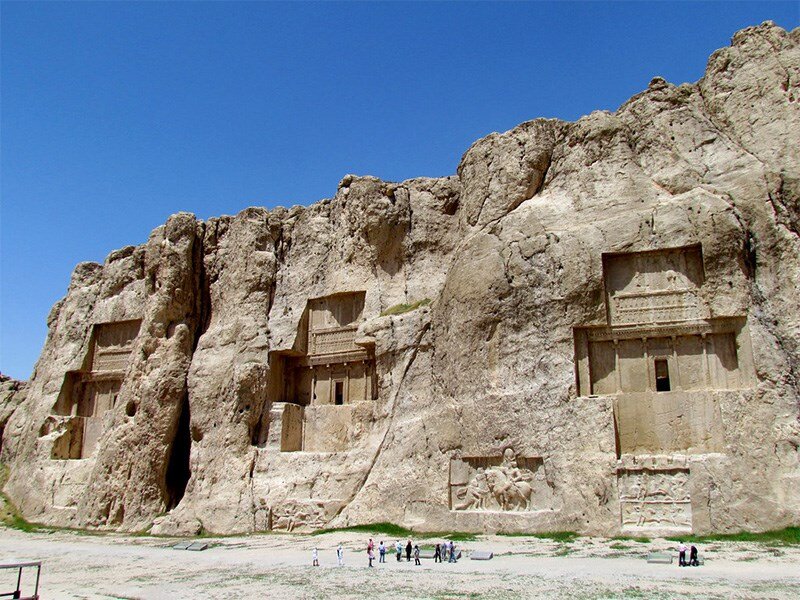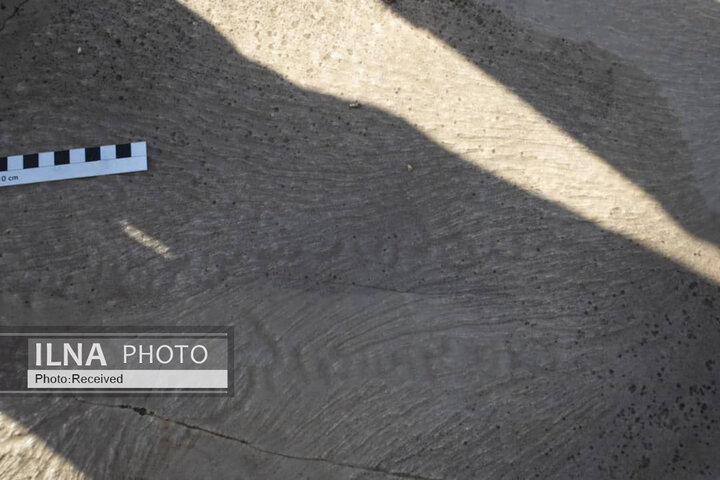Sassanid inscription bearing prayer for mental health discovered in southern Iran

TEHRAN – A team of cultural heritage experts have found a rack-carved Sassanid inscription that bears prayer for mental health.
The inscription is suffered due to rain, sunlight, and other natural elements for some 1,600 years, was found in the treasured site of Naqsh-e Rostam, southern Iran, ILNA reported on Tuesday.
According to Iranian linguist and historian Abolhassan Atabaki, the inscription dates from the late Sassanid period (224 CE–651) and shows part of the views and thoughts of the people of that time, the report said.
This inscription is inscribed in two lines, and it depicts a plea for mental health for holy people, Atabaki said.

Due to the type of sedimentary limestones and heavy rains for about 1600 years, harmful erosion has occurred on the stones of this place, so that the first line of this inscription is turned darker than nearby sedimentary rocks, he explained.
“Nevertheless, we tried to read this stone inscription, which has practically lost some of its letters and words.”

This inscription is a commemorative or prayer inscription written by a Zoroastrian follower, he said.
Another expert, Najmeh Ebrahimi, says: “Due to excessive erosion of the first line of the stone inscription, the distinction between words and letters is not very clear, so we processed the words of this line with speculation.”
The inscription reads: “The glory of creation… May the soul of a pious person be healthy.|
A must-see tourist destination
Massive rock–hewn tombs and bas-relief carvings at Naqsh-e Rostam have turned the ancient site into a must-see for holidaymakers traversing the Marvdash plain. The Achaemenid necropolis is situated near Persepolis, itself a bustling UNESCO World Heritage site near the southern city of Shiraz.
Naqsh-e Rostam, meaning “Picture of Rostam” is named after a mythical Iranian hero which is most celebrated in Shahnameh and Persian mythology. Back in time, natives of the region had erroneously supposed that the carvings below the tombs represent depictions of the mythical hero.
One of the wonders of the ancient world, Naqsh-e Rostam embraces four tombs where Persian Achaemenid kings are laid to rest, believed to be those of Darius II, Artaxerxes I, Darius I, and Xerxes I (from left to right facing the cliff), although some historians are still debating this.
There are gorgeous bas-relief carvings above the tomb chambers that are similar to those at Persepolis, with the kings standing on thrones supported by figures representing the subject nations below. There are also two similar graves situated on the premises of Persepolis probably belonging to Artaxerxes II and Artaxerxes III.
Beneath the funerary chambers are dotted with seven Sassanian bas-reliefs cut into the cliff depict vivid scenes of imperial conquests and royal ceremonies; signboards below each relief give a detailed description in English.
At the foot of Naqsh-e Rostam, in the direction of the cliff face, stands a square building known as Ka’beh-ye Zardusht, meaning Kaaba of Zoroaster. The building, which is roughly 12 meters high and 7 meters square, probably was constructed in the first half of the 6th century BC, although it bears a variety of inscriptions from later periods.
Though the Ka’beh-ye Zardusht is of great linguistic interest, its original purpose is not clear. It may have been a tomb for Achaemenian royalty or some sort of altar, perhaps to the goddess Anahiti, also called Anahita believed to be associated with royalty, war and fertility.
A general renaissance
The Sassanid era is of very high significance in Iranian history, under which Persian art, and architecture experienced a general renaissance.
Architecture often took grandiose proportions such as palaces at Ctesiphon, Firuzabad, and Sarvestan which are amongst the highlights of the ensemble.
Crafts such as metalwork and gem engraving grew highly sophisticated, yet scholarship was encouraged by the state. In those years, works from both the East and West were translated into Pahlavi, the language of the Sassanians.
Rock-carved sculptures and bas-reliefs on abrupt limestone cliffs are widely deemed as characteristics and striking relics of Sassanian art, top examples of which can be traced at Bishapur, Naqsh-e Rostam and Naqsh-e Rajab in southern Iran.
AFM
